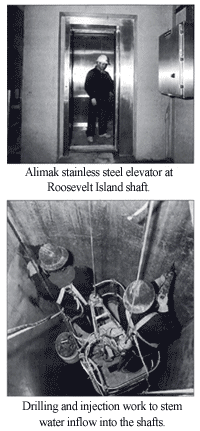 Chemical Grout Chemical Grout
Cementitious grout used in the concrete shaft liners has not been completely satisfactory in stopping water inflow, and Gottleib contracted with grout specialist, SsesCo, Inc. of Hyde Park, Massachusetts for correcting the situation at a cost of US $1.3 million.
Various chemical grouts could
be successfully used for the project. However, by matching the most suitable
grout to the conditions, Ssesco saved the DEP about US $1.6 million for the job.
The Chemical grout selected was Hydro Active Seafoam, manufactured by de Neef Construction Chemicals, Inc, of Waller, Texas. The product is a low viscosity polyurethane injection-type resin designed to control water inflows and seal moving non-structural cracks in concrete. It is a hydrophilic resin that cures and expands into a closed cell foam with the introduction of water.
One of the biggest rehabilitation projects in North America where de Neef
resins were used was in the Chicago Transit Authority’s subway tunnel
system. Here a contract was awarded, in 1992, to the contractor GKN/Hayward
Baker, just after the Great Chicago Flood because
of substantial water inflow at the tunnel’s joints. The contractor injected
de Neef hydro active resin and in 1993 an inspection of all repaired joints
revealed no leaks.
Ssesco chose this resin over others available to them because of the extraordinary
quick resin setup time of 30 to 60 seconds, depending on the resin temperature
at time of injection. To maintain a pre-injection resin temperature between
32° and 38° C, electric band heaters were wrapped around the 5-gallon (18.932)
resin containers.
The quick setup time reduced the quantity of resin required to seal the cracks and avoided the need to inject a slower curing grout into the same packers two and three time over to assure a complete seal.
Portable piston type grout pumps, rated at 3,000 psi, and conventional electric powered hand drills were the tools used for installing the packers and injecting the grout. A two-man crew drilled the concrete shaft wall with thirty-five holes, 229 mm deep, installed the packers, injected the grout and cleaned up the injection area within 8 hours. The packers were installed in a grid configuration with the spacings ranging 254 to 305 mm square. The smaller grid patterns were needed where the water inflow was greatest. The specially trained injection crews were overseen by a foreman and a superintendent.
Weiburg says the latest shaft scheduled to be built, 26B in Manhattan, is
the first where they had cost provisions for chemical grouting included in
the contract. He says this eliminates the time consuming process of making
a change
order. Future shafts will be designed with water liners, thus eliminating this
grouting procedure.
Once the Stage-I tunnel segment has been put into service this year, Tunnels I and II will be shutdown and at separate times for inspection and maintenance work. The Stage-II tunnel segment will be completed by 2002.
by Rodney Garrett, Technical Journalist
North American Tunneling
|

